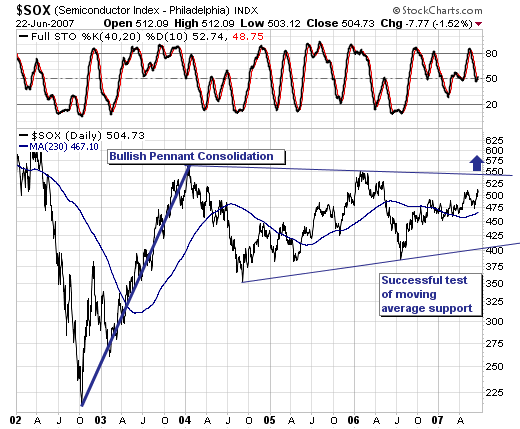This week, I thought we'd revisit an article I wrote way back in November of 2001 about the "Six Steps" you can take at StockCharts.com to quickly guage the overall health of the market and find great stock opportunities. While the graphs are all out-dated now, the concepts are still very valid and hopefully helpful. Enjoy! - Chip
We get lots of questions about what the best way to use StockCharts.com is, so this week I thought I'd incorporate one answer to that question into the newsletter. While there is no 100% best way to use all of the resources that StockCharts provides, here's the routine that I follow at least once a day. Its goal is to offset all of the panicky, rush-rush information that the financial media spits out with a calm, top-down approach to market analysis. It incorporates all of the major tools on StockCharts and provides me with my technical "feel" for what's really happening to the markets. Here are my steps:
Step One - Gauge the Performance of the Major Markets
Up, Down, or Sideways? The market has to be moving in one of those three directions, right? So which way is it? Often, the media will mislead you badly when it comes to answering this simple question. As always, it boils down to time frame. Are you looking at the last minute, hour, day, week, month, year or decade? Each timeframe often has a different answer from the next. To deal with this question, I always start with our Major Market PerfChart.

The key to using the tool correctly is to s-t-r-e-t-c-h the slider! Don't just stare at the chart like a zombie! Grab your mouse, grab the left edge of the slider at the bottom of the chart (see where my cursor has turned into a double-arrow in the picture above?), and start stretching! Find the major turning points in the market and stretch or shrink the slider until they are at the left edge of the chart. Only then can you really see how the major averages have done. By boiling everything down to percentages, uptrends and downtrends become clearer as does the other critical thing to look for - divergences. In early 2000, the blue chip averages diverged sharply from the high-tech stocks, signaling trouble ahead. Stretch your slider until you see this divergence clearly. It's the best argument I know of for checking this chart religiously.
After getting the longer term performance picture, press the F1 key. Boom! There's the last week in a nutshell. Now press F2. Bang! There's last month for ya. Finally - you guessed it - F3. Ka-blammo! Year-to-date in one pretty picture. Always start with this chart and don't leave it until you have a firm grasp of how the major averages are doing.
Step Two - Examine the Intermarket Picture
Bond prices, Commodity prices, and the Dollar all affects stock prices. And stock prices affect them. And they all affect each other. John Murphy has written about these intermarket linkages extensively. We maintain a special "Intermarket" PerfChart just for studying these linkages - specifically seeing whether each of these things are moving in tandem or moving apart (diverging). As we explain below the chart, you should look to see if three key things are happening: Are stocks and bonds moving in the same direction? Are commodities and bonds moving in different directions? Is the Dollar moving in a different direction from commodities?
 To study each of these relationships, hide the other two lines by clicking on the colored box for that line above the top of the chart. Now start sliding that slider. Look at the direction of the movements, not necessarily the magnitude. If you can make the two likes look like "mirror images" of each other (with the zero line in the middle), then they are moving in an INVERSE relationship. For example, the chart on the left shows the current inverse relationship between commodities and the US Dollar. If you can get both lines above or below the center line, they are currently in a POSITIVE relationship. Study each of the three key intermarket relationships using this technique, then compare your results to the comments below the chart. This information helps you gauge the health of the market's current trend.
To study each of these relationships, hide the other two lines by clicking on the colored box for that line above the top of the chart. Now start sliding that slider. Look at the direction of the movements, not necessarily the magnitude. If you can make the two likes look like "mirror images" of each other (with the zero line in the middle), then they are moving in an INVERSE relationship. For example, the chart on the left shows the current inverse relationship between commodities and the US Dollar. If you can get both lines above or below the center line, they are currently in a POSITIVE relationship. Study each of the three key intermarket relationships using this technique, then compare your results to the comments below the chart. This information helps you gauge the health of the market's current trend.
Step Three - What's Sector Rotation Saying About the Economy?
Last week, we talked about Sector Rotation and the PerfChart that we use to analyze it. By "reverse engineering" the state of the economy from the strength of the various sectors, you can stay 2-3 months ahead of those big-whig economists and their lagging Government reports. Read last week's newsletter for more details.
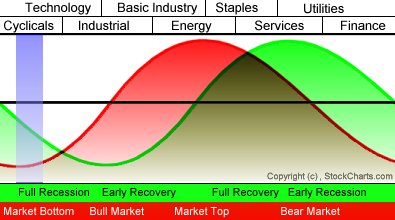
Step Four - Study the Yield Curve
January 26th, 2000. That's when the one of the best signals for a looming market top was given. On January 26th, 2000, the Yield Curve inverted. Our Dynamic Yield Curve analysis tool shows this clearly. Never, never, never ignore the Yield curve. It can also be used to confirm the state of the economy from your Sector Rotation analysis. See the bottom of the Sector PerfChart page for details.
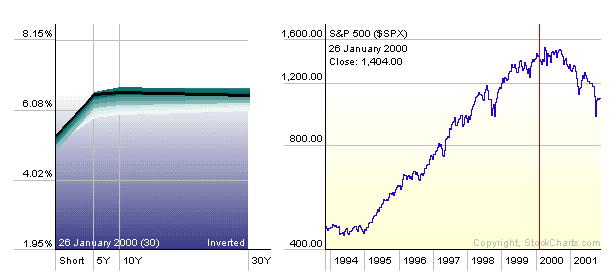
On the live version of this chart, don't forget to click around on the S&P part to see where the yield curve was at that point in time.
Step Five - Does Market Breadth provide Confirmation?
OK, by now you should have a good sense of where the markets are and where they may be headed. Now, study the market breadth charts and see if they support your conclusion. Many people like to start their analysis with breadth charts like the Advance-Decline lines, the McClellan Summation charts, and the Bullish Percent Indices. I think that is a mistake. Since the markets are the subject of this whole endeavor, they should be studied directly. Secondary data like breadth and volume should be "held in reserve" to confirm or dispute the analysis of the primary data - i.e. prices.
That said, now is the time. I LOVE THE BULLISH PERCENT INDICES! They are unlike anything else out there in that they summarize the price action of hundreds of charts, boiling them down to a percentage. What could be simpler? You don't even need to understand P&F charting to use these things! Our Bullish Percent CandleGlance page has everything you need. I look at it every evening.
The McClellan charts that we get from the good folks at DecisionPoint.com are the perfect compliment to our BPI charts. I'd never bet against the Summation Index. When it changes direction, the market's current trend is in doubt.
Step Six - Creating the "Hot/Not" List
OK, we've developed a solid understanding of the big picture (the market), now we can drill down with confidence and the Sector Market Carpet is where I go next. Updated throughout each trading day, the carpet shows me at a glance which sectors (and stocks within those sectors) have done well during the past day, the past week, and the past month. It's almost like seeing an X-ray of the S&P Sector PerfChart.
Some things I look for: Within each sector, do the brightly colored square (red or green) cluster towards the upper left corner of the sector (where smaller-cap stocks are) or do they cluster towards the lower right corner (the mega-caps)? Are there any sectors with (for instance) one or two bright-red squares with the remained light green (and thus the sector's overall rating could be misleading). How does the carpet change when I switch it to absolute RSI mode (select RSI from the dropdown, unclick the 'Delta' button - see the instructions page for details)? Next, I switch to RSI Change mode for the current week (click the 'Delta' button and then press F1). Which sectors (look at the number in the upper right corner of each sector's area) had the best improvement in overall RSI? Which stocks in those sectors led the way?
All of this visual carpet information goes into the making of my tentative "Hot/Not" list - stocks that I think are worth additional investigation. When I spot a promising stock that's part of a sector that, based on the previous steps, also looks promising, it goes on this list.
The Real Work Begins At the End
After completing these six steps, I am ready to analyse my Hot/Not list in detail using one or more of the more common TA techniques - P&F signals, chart patterns, support/resistance, Elliot Wave methods, candlestick signals, stock scans, indicator signals, etc. (all covered in our ChartSchool). Many people start their analysis process by using these techniques on individual charts. I think that is also a mistake. By taking the time to develop and confirm a sense of where the markets and sectors are going before looking at individual stocks you will always have the big picture in mind and can add the calm voice-of-reason to your investment decisions.
Again, there are hundreds, even thousands of different ways to look at the markets. This technique is only one of those ways. I offer it in the hopes that you'll take it and use it as a starting point for developing your own analysis routine that builds upon these ideas. Good luck!
The S&P Midcap ETF (MDY) remains in an uptrend for now, but a lower high and waning upside momentum are cause for concern. The ETF established support around 160-161 with reaction lows in May and June. In addition, the rising 50-day moving average marks support in this area. The ETF formed a lower high six days ago and a break below key support at 160 would forge a lower low. This would be medium-term bearish and call for a retracement of the March-June advance.
According to the Aroon indicators, the upside is loosing momentum and the downside is gaining momentum. The uptrend was strong as long as Aroon Up (green) held above 70, which was from 3-Apr to 14-Jun. Aroon Up moved below 50 for the first time since 2-April and upside momentum is waning. In contrast, Aroon Down (red) moved above 50 for the first time since late March and downside momentum is increasing. Look for a move above 70 in Aroon red to signal an acceleration of downside momentum and confirm a support break at 160.
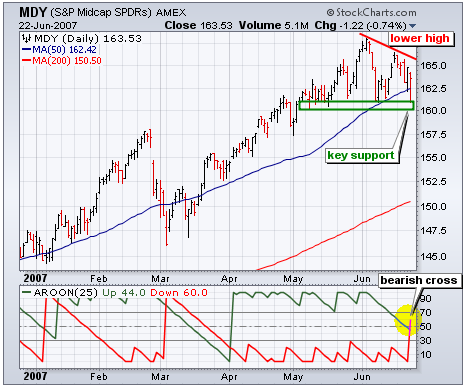
On our first chart, a daily bar chart, we can see that bonds have been weakening for several months, with the most dramatic decline occurring in the last month or so. The question that comes to mind is whether this weakness is a correction in a longer-term up trend or the start of a more serious decline? Since the 50-EMA is below the 200-EMA, we have to assume that bonds have entered a long-term down trend. This situation could change fairly quickly, but for now we need to maintain negative assumptions.

The second chart, a monthly bar chart, helps us put the decline into a very long-term context. Note that bond prices have been within a long-term rising trend channel for over 20 years, and that the recent decline has been stopped (so far) by the long-term rising trend line. This offers some hope that the decline may be over.
On the negative side there is an ascending wedge that has been forming within the rising trend channel. This is a bearish formation, and the technical expectation is for it to resolve to the down side. This month the price index did break down from the wedge, an event that has negative long-term implications.
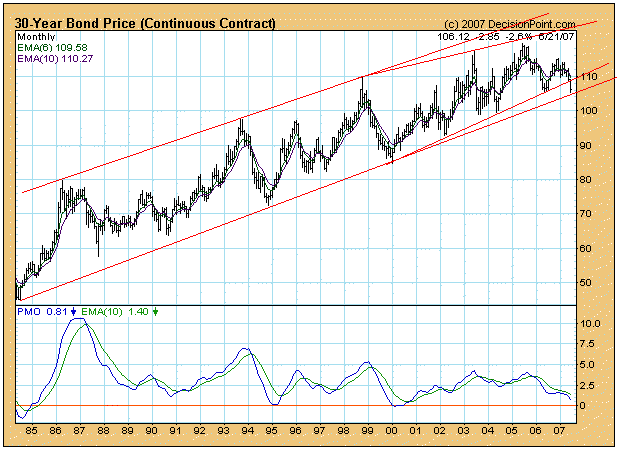
Bottom Line: My opinion is that bonds are forming a long-term top and are entering a long-term decline. All the signs are negative except that the long-term rising trend remains intact, no small exception that.
I discussed many months ago how the rotation from the tech-heavy NASDAQ to the safety of the Dow Jones evolves over time. As earnings disappoint and growth slows, money moves away from the high octane growth stocks to the more conservative components of the Dow. That's what we saw back from 1984 through 1991 and again from 2000 to 2002. But when our economy grows and earnings begin to expand, money flows in the opposite direction - away from the Dow and into the NASDAQ. I believe we remain in this latter environment. Our economy is expected to grow in the second half of 2007 and into 2008 and if inflation remains in check, and I believe it will, this environment sets up beautifully for the higher growth NASDAQ stocks.
In Chart 1, I have reposted a chart from last October's newsletter showing the relationship between the Dow Jones and the NASDAQ since 1980. This "Flight To Safety Ratio" (calculated by dividing the Dow Jones Industrial Average by the NASDAQ) moves higher as money searches for the "safe haven" and moves lower as the NASDAQ leads during higher growth periods. You can see the down channel that has developed since 2003. Over the next 2-3 years, I'm expecting a continued move lower in this Flight To Safety Ratio to a point somewhere in the 4.00-4.25 range, marking a long-term bottom.
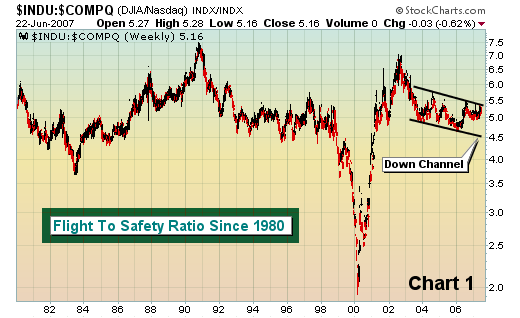
Chart 2 below shows a clear view of how the money rotates when the market fears that future earnings growth is in jeopardy. Recall last May through July as oil and other commodity prices surged and fears raged that higher commodity prices would mean higher inflation. The high growth NASDAQ plummeted much faster than the Dow Jones and S&P 500, resulting in a very quick spike in the Flight To Safety Ratio (Point A). Those fears were never realized however and market participants quickly moved money back to the higher growth equities on the NASDAQ by the end of 2006 (Point B). Then just recently, the increasing yield on the 10 year treasury note heightened levels of fear about future economic growth and again the money flowed out of growth and toward the safer Dow components (Point C). I believe our economy will strengthen during the balance of 2007 and into 2008 and we'll see this ratio continuing down in the channel that was illustrat ed in Chart 1.
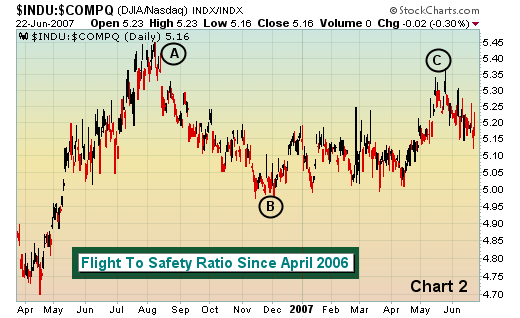
There remains a lot of pessimism in the market as evidenced by very high historical put call ratio readings and a spiking VIX (volatility index). These two factors historically promote continued bullishness and do not coincide with long-term tops. If equity prices continue higher and economic growth keys the rally, you have to favor the higher PE stocks found on the NASDAQ.
Last week's stock market correction was rather "brutal" to be sure; however, we believe that the balance of evidence suggests at this time it is nothing more than a correction and more likely a consolidation to higher highs. If this is so, then we want to be long those stocks that shall "lead" the market higher. At this juncture, our models and analysis argues that using current weakness in the semiconductor sector to accumulate shares will provide outsized gains in the months ahead.
Looking at the daily chart of the Semiconductor Index ($SOX), we find a rather longer-term, large and clear bullish pennant consolidation has formed. Of course the ultimate resolution should obviously be higher; and if we use the percentage measurement of the Oct-2002 to Jan-2004 rally added to the July-2006 low ? then we arrive at rough reading of 1000 or nearly a 100% increase from current levels. We have a very hard time believing this given our skeptical nature, but this is simply a hard and fast technical measurement. In any case, moving average support has held, and a breakout above pennant resistance will likely lead to a "melt-up" of some degree given the large short position outstanding in the semiconductor sector and its relative "unattractiveness" over the past 4-years in which it has underperformed the S&P 500.
Every dog has its day they say; perhaps now it's the Semiconductors turn to bark.
